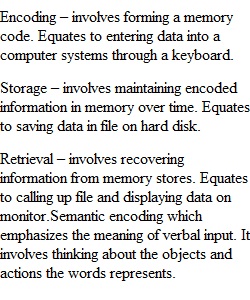


Q Please answer the following questions and submit them for grading. 1. Briefly explain encoding, storage, and retrieval and equate each to a computer system. 2. Name the "deepest" level of encoding processing and explain the construct. 3. Describe the Dual Coding Theory of encoding. 4. What is the average number of digits an adult can recall during a short-term memory task? 5. Describe Sensory, Short-term Memory, and Long-term Memory..... How long does each last if unattended to? 6. What does it mean to "chunk" information when trying to remember/learn something? 7. What is the difference between a "Flashbulb" memory and "Infantile" Amnesia? What one thing might a flashbulb memory and an early memory have in common? 8. What is the difference between retroactive and and proactive interference? 9. What two "cues" are subcomponents of the Encoding Specificity Principle? 10. What is the psychological term for "Motivated Forgetting"? 11. What is the difference between retrograde amnesia and anterograde amnesia? 12. Give one example each of a: Nondeclarative memory, a semantic declarative memory, and an episodic declarative memory. 13. Give at least one example of a prospective memory.
View Related Questions